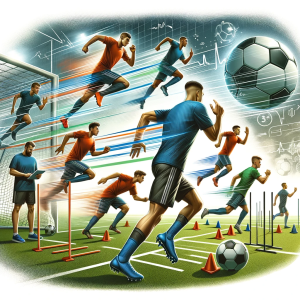
Player Tracking Data is Revolutionizing Player Development
Soccer, the beautiful game, is undergoing a quiet revolution. No, it’s not a new tactical formation or a groundbreaking coaching method. Instead, it’s a technological transformation powered by player tracking data. This article delves into the fascinating world of sports analytics, particularly focusing on soccer, and explores how tracking data is reshaping coaching and player development.
The Rise of Player Tracking Data
In recent years, player tracking data has become an essential tool in the sports industry. It involves capturing the spatiotemporal positions of players and the ball during games. This data is collected using various technologies like GPS, optical tracking systems, and computer vision. The sheer volume and granularity of this data have opened new avenues for analyzing player performance and game strategies.
From Data to Insights: Understanding the Basics
Imagine watching a soccer match and seeing not just the players moving but also a digital layer of data highlighting their speed, distance covered, and positioning. Player tracking data provides exactly that level of detail. With sampling rates often between 25 to 100 Hz, tracking systems can generate millions of data points in a single match. This data can be overwhelming, but it holds the key to unlocking profound insights into the game.
Key Applications in Soccer
- Performance Metrics:
- Distance and Speed: Traditional metrics like distance covered and speed are now more accurate. Coaches can precisely measure how much ground a player covers and their speed at different game phases.
- Load and Fatigue Management: By analyzing velocity and acceleration, teams can monitor players’ physical load, helping prevent injuries and optimize recovery.
- Tactical Analysis:
- Formation and Space Control: Using Voronoi diagrams, analysts can visualize which areas of the pitch are controlled by which players. This helps in understanding team formations and spatial dominance during different game phases.
- Movement Patterns: Tracking data reveals players’ movement patterns, which can be used to develop tailored training programs and game strategies.
- Event Prediction and Decision-Making:
- Predicting Play Outcomes: Advanced models can predict the likelihood of different play outcomes, such as goals or successful passes, based on players’ positions and movements.
- Value Attribution: Metrics like Expected Possession Value (EPV) quantify the value of each action, helping coaches understand which decisions contribute most to the team’s success.
Overcoming Methodological Challenges
Despite its potential, player tracking data poses several challenges:
- Data Volume: Handling and analyzing millions of data points require robust computational tools and methodologies.
- Multidimensionality: Representing the spatiotemporal dimensions of tracking data in meaningful ways is complex. Researchers often use advanced statistical and machine learning models to address this.
- Contextual Analysis: Soccer is a highly contextual game. Factors like player roles, game state, and opponent tactics must be considered in analysis, necessitating sophisticated multilevel models.
Real-World Implications for Soccer Coaching
- Tailored Training Programs: By understanding individual players’ movement patterns and physical loads, coaches can design personalized training regimes that target specific areas for improvement and prevent overtraining.
- Enhanced Game Strategies: Tactical decisions can be informed by precise data on how different formations and player positions impact game outcomes. Coaches can simulate various scenarios to find optimal strategies.
- Player Development: Young players can benefit from data-driven insights early in their careers. Tracking data can highlight strengths and areas for development, allowing for more focused coaching interventions.
Conclusion
Player tracking data is more than just numbers on a screen; it’s transforming soccer from the grassroots to the professional level. By providing unprecedented insights into player performance and game strategies, it’s helping coaches make smarter decisions and players reach their full potential. As technology continues to evolve, the beautiful game will only get more fascinating.



